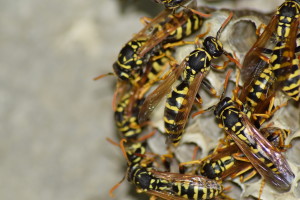 Wasps differ from bees both physically and behaviourally. They are brightly coloured often bright yellow and black while bees are more orange-brown. Wasps tend to have long, hairless bodies. Meanwhile bees are stout and very hairy. These species are predators and scavengers, feeding on a variety of common food substances such as sweet beverages, fruits and meat-based products and on other insects. Wasps do not feed on nectar and do not produce honey. Wasps are more aggressive than bees and they sting multiple targets or times without losing their stings. Bees sting once, losing their stings and dying eventually.
Wasps differ from bees both physically and behaviourally. They are brightly coloured often bright yellow and black while bees are more orange-brown. Wasps tend to have long, hairless bodies. Meanwhile bees are stout and very hairy. These species are predators and scavengers, feeding on a variety of common food substances such as sweet beverages, fruits and meat-based products and on other insects. Wasps do not feed on nectar and do not produce honey. Wasps are more aggressive than bees and they sting multiple targets or times without losing their stings. Bees sting once, losing their stings and dying eventually.
Prevention tips
- Do not leave sugary foods out in your backyard uncovered. When picnicking cover all foods especially the ones that attracts them, i.e. meat, sugary or sweet food or beverages. It is preferable to use covered containers.
- Clean up food spills and crumbs whenever possible
- Use covered garbage bins with tightly fitting lids to keep these insects out. Empty the garbage daily, or wash it down or replace lining to prevent attraction.
- Keep outdoor garbage bins away from doors, windows and areas where people sit, recreate, eat or play
- Since wasps like nesting in cracks and crevices or structural voids, exclude them by eliminating such potential sites or access on the property

